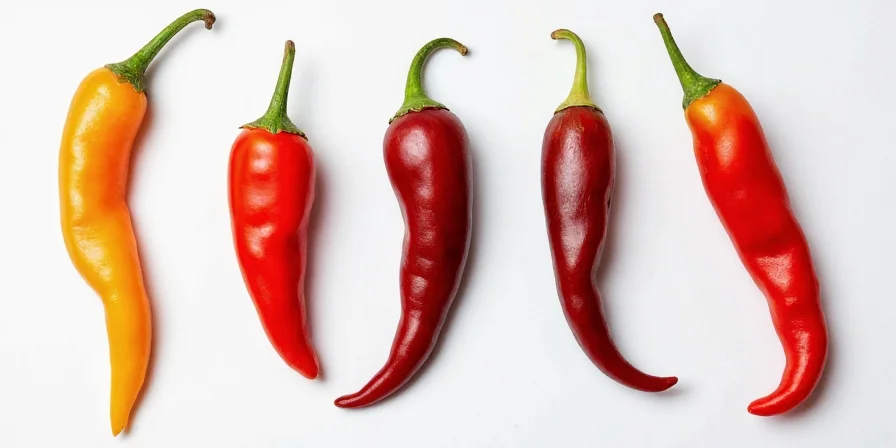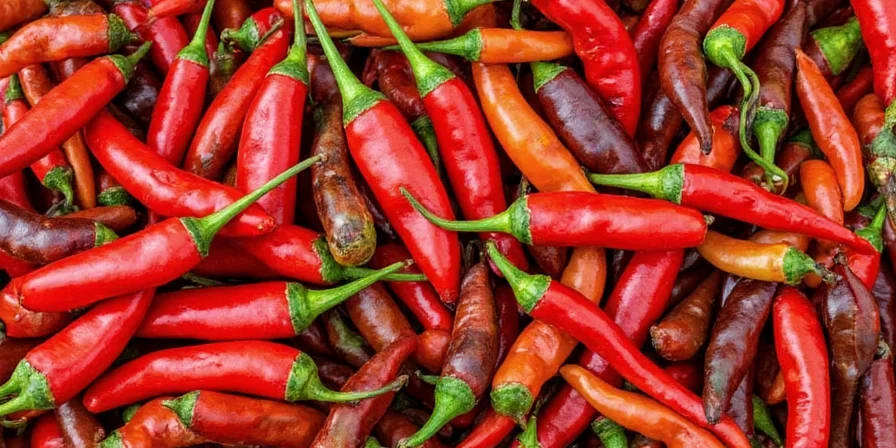Chile pepper heat levels range from mild poblanos (1,000-2,000 SHU) to extreme ghost peppers (855,000-1,041,427 SHU). This guide provides immediate clarity on chile comparisons, safety protocols for handling hot peppers, and practical substitution ratios for home cooks. You'll learn exactly which chiles work for your heat tolerance level and how to use them safely in everyday cooking.
Chile Heat Level Comparison (Mild to Extreme)
| Chile Type | Heat Level (SHU) | Heat Comparison | Safety Rating |
|---|---|---|---|
| Poblano/Ancho | 1,000-4,000 | Mild (1-3x jalapeño) | ★★★★★ |
| Jalapeño | 2,500-8,000 | Moderate (baseline) | ★★★★☆ |
| Serrano | 10,000-23,000 | Medium-Hot (2-3x jalapeño) | ★★★☆☆ |
| Habanero | 100,000-350,000 | Very Hot (20-40x jalapeño) | ★★☆☆☆ |
| Ghost Pepper | 855,000-1,041,427 | Extreme (100-200x jalapeño) | ★☆☆☆☆ |
Immediate Safety Note: Ghost peppers require nitrile gloves, eye protection, and ventilation. Never handle bare-handed. Keep whole milk (not water) nearby for accidental exposure. Children and sensitive individuals should avoid.
Poblano: The Mildest Culinary Workhorse
Poblanos (1,000-2,000 SHU) are ideal for beginners seeking mild heat with deep flavor. Fresh poblanos offer gentle warmth while dried anchos develop complex raisin-like notes essential for authentic mole sauces.

Practical Usage Tips:
- Best for stuffed chiles rellenos (seeds removed)
- Foundation for beginner-friendly mole sauces
- Roast and add to soups for subtle depth
- Dried anchos require 20-minute soaking before blending
Substitution Ratio:
Replace 1 jalapeño with 2 poblanos for milder dishes. Ideal for family-friendly Mexican cuisine.
Jalapeño: The Balanced Heat Standard
Jalapeños (2,500-8,000 SHU) provide consistent, moderate heat perfect for developing heat tolerance. Their predictable Scoville range makes them the go-to pepper for daily cooking.

Heat Control Techniques:
- Remove seeds/membranes for 50% less heat
- Roast to caramelize natural sugars
- Slice lengthwise for even heat distribution
- Pair with dairy to counteract capsaicin
Everyday Applications:
Raw in salsas, cream-based sauces, and stuffed preparations. The culinary "baseline" for heat comparisons.
Serrano: The Bright Medium-Heat Alternative
Serranos (10,000-23,000 SHU) deliver reliable medium heat with superior crispness. They maintain structural integrity better than jalapeños in raw applications.

When to Choose Serrano Over Jalapeño:
- Raw pico de gallo (better texture retention)
- Vinegar-based hot sauces
- Cocktail garnishes requiring clean heat
- Salsas needing brighter flavor profile
Pro Tip:
Thin slicing maximizes surface area for even heat distribution. Retain seeds for salsas requiring 15-20 minute steeping time.
Habanero: Tropical Fruit Heat (Handle With Care)
Habaneros (100,000-350,000 SHU) deliver intense heat with distinctive citrus notes. Always wear nitrile gloves when handling—capsaicin concentration varies significantly between individual peppers.
Safety Protocol:
- Wear nitrile gloves (latex is permeable)
- Work in ventilated area
- Remove ALL seeds for balanced heat
- Taste-test individual peppers first
Beginner-Friendly Applications:
Use 1/4 habanero (seeds removed) per cup of sauce. Ideal for fruit-based hot sauces, mango salsas, and Caribbean marinades. The heat builds slowly—allow 15 minutes for full effect.
Ghost Pepper: Extreme Heat Management Protocol
Ghost peppers (855,000-1,041,427 SHU) require strict safety protocols. Their heat registers 100-200 times hotter than jalapeños. Never consume raw.

Mandatory Safety Checklist:
- Nitrile gloves AND eye protection
- Ventilated workspace (outdoors preferred)
- Isopropyl alcohol for surface cleaning
- Whole milk (not water) for accidental exposure
- NO children or sensitive individuals present
Controlled Usage Guide:
- Start with 1/16 teaspoon dried powder per dish
- 1 seed per cup for finishing oils
- Never use in home cooking for children
- Commercial hot sauces only (professionally diluted)
Practical Chile Selection Guide
Choose chiles based on your heat tolerance and dish requirements:
- Family-friendly meals: Poblanos (1,000-4,000 SHU)
- Daily cooking: Jalapeños (2,500-8,000 SHU)
- Enhanced heat: Serranos (10,000-23,000 SHU)
- Special occasion heat: Habaneros (100,000-350,000 SHU)
- Professional use only: Ghost peppers (855,000+ SHU)
Remember: Capsaicin binds to fat, not water—dairy neutralizes heat more effectively than water. Always build heat gradually and document your ratios for consistent results. Modern culinary applications now include chile-infused chocolates and craft cocktails, demonstrating their versatility beyond traditional savory roles.
Frequently Asked Questions
How can I safely handle habaneros at home?
Always wear nitrile gloves, work in a ventilated area, and remove all seeds. Taste-test individual peppers first as heat varies significantly. Clean surfaces with isopropyl alcohol after handling. Keep whole milk nearby for accidental exposure—water won't help.
What's the easiest chile for beginners to start with?
Poblanos are ideal for beginners (1,000-4,000 SHU). They provide mild warmth with deep flavor and pose minimal safety risks. Use 2 poblanos to replace 1 jalapeño in recipes for family-friendly meals. Their large size makes them easy to handle and stuff.
How do I reduce chile heat without changing flavor?
Add acidic components like lime juice early in cooking to balance heat perception. For finished dishes, incorporate dairy (yogurt or sour cream) which binds to capsaicin molecules. Never use sugar—it masks rather than neutralizes heat. Removing seeds and membranes reduces heat by up to 50% without altering flavor.
Can I substitute serranos for jalapeños in recipes?
Yes, but use 1 serrano for every 2-3 jalapeños. Serranos provide brighter, cleaner heat with better texture retention in raw applications. They're ideal when you want noticeable heat without overwhelming the dish. For cooked dishes, the heat difference becomes less pronounced after 10+ minutes of cooking.










 浙公网安备
33010002000092号
浙公网安备
33010002000092号 浙B2-20120091-4
浙B2-20120091-4